Post Nationalisation Wagon Development
British Railways inherited a mixed bag of stock, for example only about
20 percent of the LNER stock was `fitted', that is fitted with a continuous
braking system which can be controlled from the loco or brake van. By the end
of 1948 British Railways had something like a million assorted 'unfitted'
wagons and vans and about a hundred thousand 'fitted' vehicles. Roughly a third
of the rolling stock was more than twenty five years old, that is it dated from
before the 1923 grouping. There were in the region of thirty thousand 'service'
vehicles in departmental use, about twenty thousand containers of various types
and about half a million ex-private owner mineral wagons which had been bought
from their owners after the end of the war. There were still about twenty
thousand privately owned railway vehicles on the system, these being wagons and
vans carrying things like salt or lime and rail tanks for oil and other
liquids.
The wooden bodied general merchandise open wagons and more
particularly vans built by the Big Four continued in service into the 1970's or
even the early 1980's for some specialised traffic. During the war painting of
goods stock had not been a priority and the Big Four liveries were still
occasionally seen as late as the 1960's, albeit in rather dilapidated
condition. Amongst the inherited stock there were a range of vehicles for
specialised traffic and although broadly similar these differed in detail.
British Railways also received half million or so Private Owner mineral
wagons of varied design, age and quality, all of which had been worked very
hard during the second world war (most private owner mineral wagons had been
requisitioned by the government and pooled during the war). During and after
the war it was possible to see former PO wagons from widely scattered areas
operating together in a single train. The PO wagons requisitioned in 1939 were
purchased from their owners in 1947 as the new British Railways wanted to own
all the mineral wagons on the system to avoid the problems encountered in the
past with sub-standard stock. Most of these wagons were in a very poor
condition by this time, with end-door diagonal lines, plain planks and hasty
wartime repairs breaking up what remained of the livery and many were still
fitted with grease packed axle boxes. Withdrawals began in the early 1950's and
very few grease axle boxes lasted in British Railways service to the end of
that decade.
Wooden bodied mineral wagons with more modern underframes
lasted a while longer however, and ex PO steel types lasted in traffic into the
1970's. Some of the wooden bodied PO wagons were still wearing the remains of
their pre-war livery into the early 1970's. Users such as the National Coal
Board, who painted their stock bauxite lettered NCB in white, retained older
wagons including wooden bodied types, some with grease packed axle boxes, much
longer. British Railways would not accept these elderly sub-standard wagons on
its lines but they worked in the collieries into the 1980's.
Initially
British Railways carried on building wagons to the standard pre-war designs at
the existing ex-railway company works. The wartime pressure on the railways had
left a great deal of the stock in very poor condition and in the1950's British
Railways embarked on a massive restocking programme with a range of standard
designs. The increasing importance of road haulage meant that by the mid 1960's
British Railways had more wagons than it needed. Orders for new vehicles
disappeared other than for small numbers of experimental types. Older stock was
scrapped or converted for special traffics and several wagon building firms
ceased to exist. It was in this period than van traffic really began to
displace the old wooden open wagons. Based on a study of photographs from the
early 1960's you probably need one mineral wagon and one van for each open
wagon, bolster wagon or specialised vehicle on the layout. Do note however that
particular features on your layout could require additional stock of some
particular type. Most of the early British Railways goods stock was of the
standard open wagon type but beware of distortions in numbers suggested by
British Railways own advertising literature. For example there are several
pictures in various books showing short rakes of 'lowfit' ten foot wheel base
steel wagons with low drop-sides wagons each carrying a single farm tractor.
These were taken in the 1950's and 60's when interest was focused on export
drives, these loads were destined for the docks but in reality there were not
very many of this type of wagon in service.
After nationalisation
British Railways continued to build rolling stock to standard pre-war designs
but they established an Ideal Stocks Committee to look into rolling stock
design and by 1951 new standard vehicles began to appear. The standard designs
were based on the needs of the pre-war railway system and (as with just about
everyone else) the Ideal Stocks Committee failed to foresee the changes in the
transportation world. The new standard designs were based on a four wheel wagon
with a ten foot wheelbase and a payload of about twelve tons (although eight
tons would have been closer to the most common requirement). Some of the
British Railways standard wagons were very closely based on pre-war Big Four
designs. The standard British Railways brake van was basically identical in all
but minor detail to the LNER "Queen Mary" van. Corrugated steel ends on wagons
and vans, first introduced by the LMS in the 1930's, and also used by the LNER,
were adopted as standard for wagons and vans by British Railways. On the BR
designed vans hinged doors were generally preferred to sliding types but some
standard British Railways van types had sliding doors. The existing trend
toward increased use of containerisation was supported with both closed and
open container types, again of standard pre-war designs.
In 1955 the
recommendations of the Ideal Stocks Committee formed part of the grand
Modernisation Plan for the railways. Under this plan all new rolling stock was
to have a minimum wheel base of 10 foot and be fitted with an automatic vacuum
brake (AVB) to allow higher speeds. Wood was still the main building material,
although steel wagons and van designs were produced. British Railways continued
to build a large number of 'open merchandise' wagons, mainly of the five plank
type. The standard British Railways five plank wagon resembles the Graham
Farish five plank wagon body, but with corrugated ends. You can make one by
cutting away the ends of the Graham Farish wagon and replacing them with a
section of Slaters corrugated sheeting cut to fit. Alternatively you can trim
off the vertical supports on the ends and scribe along the moulded planking
using a fairly blunt tool, I would suggest scribing the insides as well if the
model is to run unsheeted or unloaded.
Fig ___ Corrugated ends on
Graham Farish open wagons
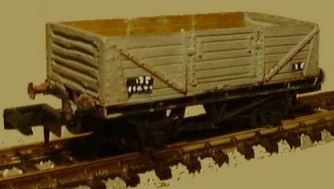
Wagons
equipped with a hinged patent tarpaulin support bar were also produced by
British Railways, albeit in limited numbers. These were only fitted to five
plank and higher sided opens, all of which were coded `Hibar' by BR.
British Railways standard open and closed containers were originally of
the pre-war wooden type. From searching through photographs the metal
containers which had been produced by the Big Four companies do not seem to
have been widely used. Metal containers do not appear to have been built by
British Railways until the late 1960's when aluminium became a practical
building material.
The official view in 1955 was that the railways
should favour vans for general goods traffic and the proportion of vans seen in
general goods trains rose steadily over the following years. This was a slow
process however and it was not until the late 1960's that vans outnumbered
opens in the general traffic stock totals (i.e. not including mineral wagons
and specialised stock such as steel carriers). British Railways built a number
of plywood sided vans based on the Big Four designs.
Fig ___ British
Railways built steel-ended plywood vans
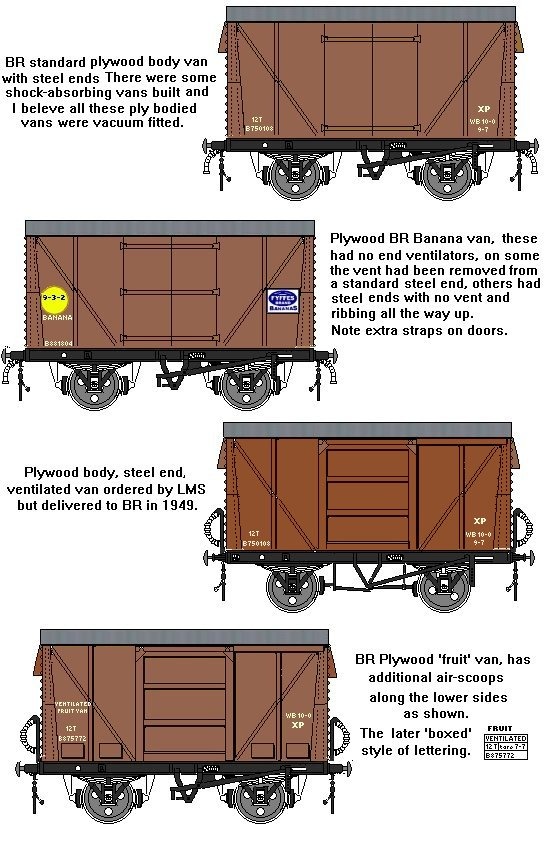
The steel-ended British Railways standard van was produced in
very large numbers, both in planked and plywood versions. The same standard
design formed the basis for a series of variants. In the 1940's and early 50's
British Railways built ventilated and insulated meat vans (this was odd as by
this time almost all meat was shipped by container). The ventilated meat van
had standard van sides, as for the Minitrix or Lima vans, but with added
louvers beside the doors (at least on some examples). The ends were ribbed
pressed metal but they had a vertical row of four vents instead of just the
single vent at the top. These vans were originally painted in passenger stock
carmine but later re-painted in bauxite. By the late 1960's most of these meat
vans were being used for normal traffic.
The insulated van used for
meat and other chilled products, had British Railways standard van sides, again
as for the Minitrix or Lima models, but with an insulating lining and with no
vents on the end. These vans were originally painted white with black
lettering. A few of the meat type insulated vans (which had hooks inside to
hang the meat on) were painted in Southern Railway 'stone' in the early days
(add a little white to Humbrol Dark Earth for this colour). All the insulated
stock was re-painted 'ice blue' with white lettering after about 1957. I
understand that these insulated vans were also used for fish but I have no
definite information on this traffic.
It is possible to convert the
Lima or Minitrix van to represent the meat or insulated types but the Parkwood
Models range now includes a set of British Railways standard planked and
ply-sided vans which includes alternative ends for the meat and insulated vans.
Fig ___ Standard British Railways Vans
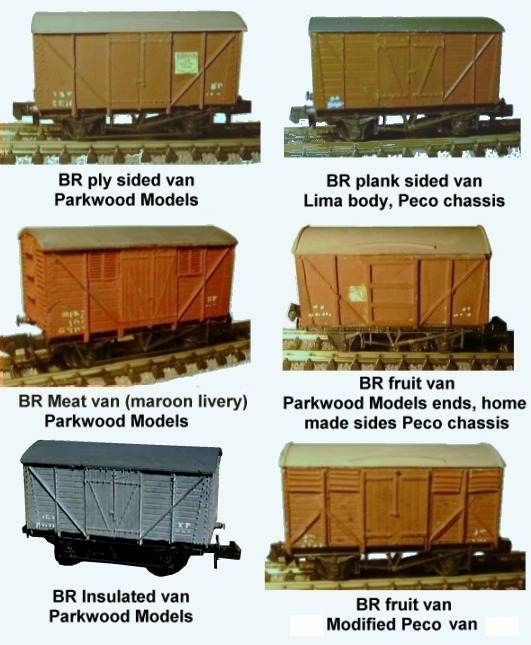
Note the Fruit
van was an early attempt, the diagonal bracing on the original Peco model was
left in place, this should have been removed as the inverted V actually met
right under the vented section at the top. A drawing can be found in the
section on Goods Rolling Stock Design - Specialised Rolling Stock.
The successful 'VANWIDE' ventilated van introduced in 1959, had a
standard 10 foot chassis and the standard pressed steel ventilated fan ends but
they had plywood sides and an ingenious design of sliding door. When closed the
doors were almost flush and the handles were long steel rods running the full
height of the doors. When pulled outwards the handles moved the door out into
tracks and opened up about half the side of the van. The ideal stocks committee
had recommended hinged doors rather than sliding types but the vanwide door
design was so successful it was later used for modern air braked stock.
Fig ___ British Railways Vanwide.
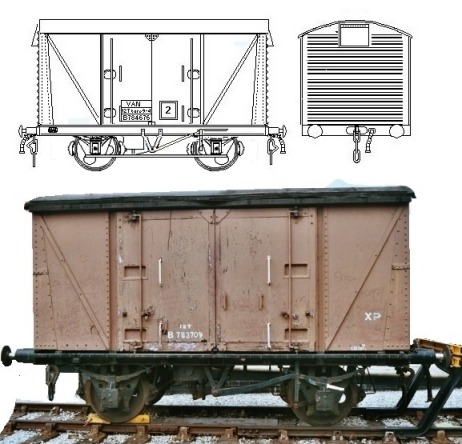
In spite of the requirement for vacuum brakes in the 1955
Modernisation Plan British Railways did build large numbers of `unfitted'
wagons. Most of these were the nine foot wheel base, steel bodied, sixteen ton
mineral wagons discussed below. Vacuum brakes were tried on these wagons but
they were not a success, amongst other things they were often damaged by the
wagon handling gear at collieries. Later batches were built unfitted and most
of the short wheelbase vehicles had the vacuum brakes removed when they passed
through the workshops (a few vacuum braked examples lasted into the 1970's).
These unfitted mineral wagons constituted the majority of British Railways
mineral stock for many years until replaced by the more modern designs of
hopper wagon. There were three common types of open mineral wagon; sixteen,
twenty one and twenty four and a half tons capacity. The sixteen and twenty
four and a half ton wagons were included in the Modernisation Plan, the twenty
one tonner was not part of the plan but in the event it remained in production
the longest.
The British Railways twenty one ton mineral wagon was a
development of the old GWR twenty ton wagons, many of which were inherited by
British Railways at nationalisation. Parkside Dundas offer the GWR type (also
used by various private owners) and a kit for the British Railways twenty one
tonner to run on the Parkside Dundas twelve foot wheelbase chassis is available
from Paul Hodgeson. Details of both these models will be found in the section
on Available Models in the subsection Kits & Continentals.
The
vacuum braked twenty one ton coal wagons were coded MDV under TOPS and survived
into the late 1980's carrying coal or colliery spoil on short workings within
Wales and for carrying scrap metal. In the later 1970's a lot of the older
twenty one ton steel wagons were re-sprung for heavier loads and re-bodied with
no end door and with only a single door on each side. These were intended for
coal traffic, and were used in some numbers for that trade, but they were also
regularly used for scrap metal.
Fig ___ British Railways Twenty One
Ton Mineral Wagons
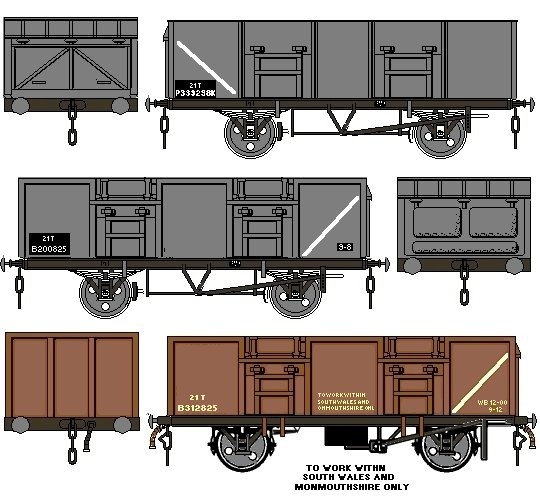
The sheer numbers produced meant that the British Railways
standard sixteen tonner dominated the scene and any British Railways layout
should have a number of these. Peco have released a very neat kit of the
sixteen ton mineral wagon on their nine foot wheelbase chassis although this
kit costs nearly as much as many of the RTR models. The Hornby Minitrix range
comes with a ten foot wheelbase 'fitted' chassis but they offer both fitted and
unfitted liveries. Lima had a model in their range but it was out of scale and
even re-mounted on a Peco chassis it did not look very convincing.
The
British Railways sixteen tonner was actually based on a series of fifteen ton
wagons built by Butterly. The Graham Farish steel open is a Butterly welded and
pressed steel design produced for the LMS in about 1945 and the Peco Butterly
steel wagon is essentially similar to the riveted version built for the LNER in
about 1947. Similar wagons were used by several private owners. Both the Peco
and Farish wagons are suitable for use in the period up to the mid 1980's
although they both benefit from shortening and the Farish wagon also need
lowering slightly to match the Peco 16 tonner kit. Toward the end of the Second
World War 10,000 steel bodied end-door mineral wagons with pressed steel side
doors were built to the same general design as the Graham Farish wagon but a
lot of these were rebuilds on older nine foot wheel base chassis I believe.
Fig ___ British Railways Sixteen Ton Mineral Wagons
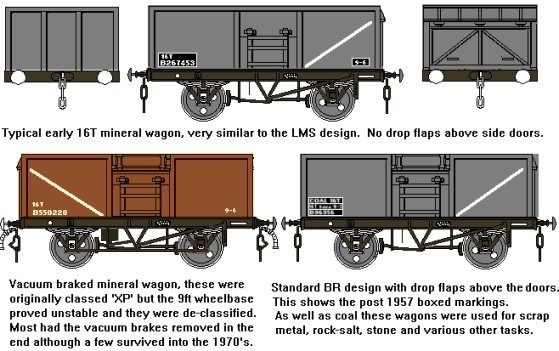
Fig ___ shows three variations on the basic design, the wagon at
the top is a typical early design very similar to those built for the LMS, note
there are no drop flaps above the doors. The wagon shown in the lower left is a
British Railways built, vacuum braked, nine foot wheelbase wagon, note the drop
flaps above the side doors introduced by British Railways. Although fitted with
a vacuum brake and originally classed as XP they proved unstable at speeds
above about forty miles per hour and all were subsequently de-classified. The
sketch in the lower right is a standard British Railways unfitted wagon showing
the post 1957 'boxed markings' (fully discussed in the Livery section).
The sixteen tonner was also regularly used for rock salt, scrap metal,
stone and aggregate (crushed stone) traffic, they remained in use into the
later 1980's and were coded MCO or MCV under TOPS. Some of the standard
unfitted steel sixteen tonners were transferred to the permanent way department
for use as 'spoil' wagons in the 1970's and some of these remained in service
into the early 1990's. As stone chipping weigh more than coal these have small
'letter box' holes (roughly four inches high by a foot long) cut about half way
up the side panels to prevent over-loading.
Fig ___ Sixteen tonner
in departmental service
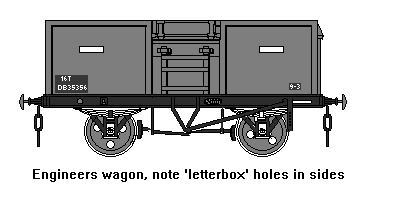
The last
coal-hoists, used for emptying end-door wagons into ships, were closed in 1987,
marking the end of revenue earning service for the sixteen ton steel wagons
(coded MCO under TOPS). A large number of the sixteen tonners were sold to the
National Coal Board for internal use at collieries.
The twenty four and
a half ton open mineral wagon was intended to replace the ageing railway
company 'loco coal' wagons. With the shift to diesel traction they were
increasingly used for revenue earning minerals traffic. All the twenty four and
a half ton mineral wagons were unfitted and ran on a twelve foot wheelbase
chassis similar to the pre-war GWR twenty ton wagons. The wagon body was based
on the standard sixteen ton wagon design but had higher sides, generally with
two doors on each side. As the contracts for building the wagons went to
several suppliers there were variations in details, some had pressed metal
doors (as seen on the Graham Farish steel mineral wagon) and some had a mix of
welded and pressed metal doors. Some had no side doors at all, being intended
for end-tipping, but these were rather uncommon. These high capacity vehicles
were used to supply power stations and larger industrial users and were also
seen carrying stone and aggregates traffic.
Fig___ British Railways
Twenty four and a Half Ton Mineral Wagons
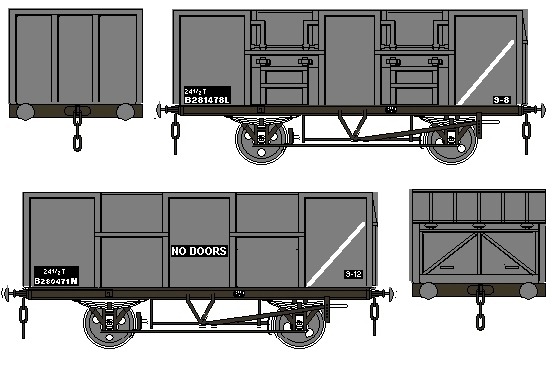
Parkside Dundas offer kits of a GWR 20 ton wagon, an LMS 20 ton loco
coal wagon and a BR 24.5 ton mineral wagon. The N Gauge Society offer a kit of
the BR 21 ton mineral wagon. Peco offer a kit of the standard 16 ton mineral
wagon. You can also make your own, the body is a simple rectangular box with
some simple strapping, only the end doors require any time and patience. It the
illustration below I have tried to show a rage of approaches to making these
wagons.
Fig___ Models of BR steel mineral wagons
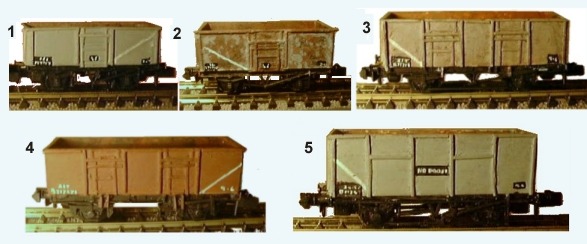
1 is a Peco butterly wagon shortened and with new ends,
mounted on a shortened Peco ten foot wheelbase chassis. The side doors have
been modified to represent the 'drop flap' upper doors.
2 is the
standard Peco 16 tonner with drop flap doors added, modelled in 'well used'
condition.
3 is a home made 21 tonner wagon on a cut down Peco
chassis. The body was made from 20 thou card, the strapping on the side doors
is all 10x20 thou strip, the end door is made up using 10x10 and 10x20 thou
strip. The drop flap doors add variety to a rake of 21 ton mineral wagon kits.
4 is the fitted version made in a similar way and again on a cut
down Peco chassis. The Graham Farish steel mineral wagon is actually too tall
and the ends from that model can be used to make a 21 tonner. The remainder of
the Farish wagon can then easily be reduced in height and new ends added to
match the size of the Peco 16 tonner.
5 is a home made 24.5 ton body
mounted on a Parkside Dundas 12 foot wheelbase chassis, it was modelled without
the side doors to add some variety to a rake of Parkside Dundas models.
British Railways also produced a standard steel bodied wagon for iron
or other ores, similar in appearance to their standard 'unfitted' sixteen ton
mineral wagon but with no doors. It was loaded from a hopper and discharged by
being turned upside down in a rotating cage or 'tippler'. If a tippler was not
available they could be unloaded by cranes equipped with grabs or, as a last
resort, by men with shovels. Peco offer a model of the standard nine foot
wheelbase early British Railways iron ore tippler wagon in kit form and
drawings of the liveries used have been included in the section on Liveries,
under British Railways.
A final variant on the steel mineral wagon was
the sand wagon, which was a door-less steel body similar to the iron ore
tippler wagon but only half the height. Peco have released a kit of the type
but the design of these wagons is simple and they would make a good
introduction to DIY wagon building. The body can be made up using plastic card
and strip and the relatively cheap Peco ten foot chassis would serve, although
the prototypes ran on nine foot wheel base chassis. Sand wagons are considered
in more detail in the section on 'Cargo and Wagon Loads'.
Fig ___
British Railways ore tippler and sand wagon

The hopper wagon, with it's quick and easy
discharge at specially prepared sites, was seen as the way forward for most
bulk materials, including grain, sand, ores, china clay and of course coal.
British Railways built a range of hopper types for coal traffic and pressed
into service hopper wagons built for other traffic. One notable example of the
latter is the iron ore hopper available from the N Gauge Society as a kit to go
on a Peco chassis (discussed below). In the north east of the country the old
North Eastern Railway had built specialised discharge facilities for its wooden
bodied twenty ton hopper wagons and British Railways built more wagons to the
same design in the 1950's as this was cheaper than modifying the coal drops.
British Railways standard hopper types introduced by in the early years
included several small mineral hoppers built to designs dating back to the
early 1930's but by the late 1950's larger capacity stock was the norm.
Probably the most common British Railways designed hopper was the
twelve foot wheelbase twenty one ton open coal hopper. For some time the only model in N Gauge was an etched brass
kit from Fencehouses (very nice when well built but tricky with all the little fillets to attach unter the base of the hopper). More recently the N Gauge Society have released a kit of the type along with a separate detailing kit (that produces a very respectable representation of the type) and Dapol have released a ready-to-run model.
Fig ___ Dapol 21 ton mineral hopper
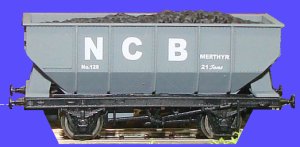
The twenty one ton hopper design was derived from an LNER twenty ton
metal bodied design dating back to the mid 1930's . The LNER wagons had been
produced in some numbers and there were over 3000 in service by the 1940's. The
LNER lacked the facilities to build these wagons so they had contracted out the
work to various wagon building firms and although all were based on the LNER
Diagram 100 this resulted in numerous small variations. During the Second World
War the same basic LNER design had been used by the Ministry of War Transport
for a fleet of iron ore hopper wagons. These MOT hoppers differed in having
thicker plates for the hopper body and were rated to carry twenty one tons but
otherwise appear identical. The British Railways liveries for the standard
twenty one ton hoppers will be found in the Liveries section, the sketches
below show the LNER twenty ton and MOT twenty one ton liveries dating from 1935
and 1947 respectively.
Fig ___ LNER/MOT steel bodied hoppers
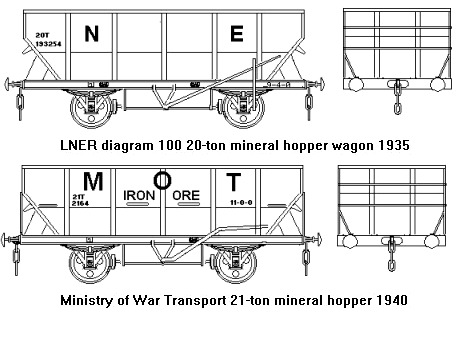
These hoppers and the British Railways built examples were coded
HTO (unfitted) and HTV (vacuum brake fitted) under TOPS and survived into the late 1980's carrying coal, road stone and
sand. They were used all over the country to supply house coal depots but in
their later years they were mainly confined to South Wales. As recently as the
mid 1980's they were operated as block trains on inter-regional work but as
they were vacuum fitted they could not travel in Speedlink services after 1984.
There is an etched kit of the type available from Fencehouses Model Foundry,
but that does require some experience on the part of the modeller. The N Gauge
Society has now released a plastic kit of the type, supplied with the Parkside
Dundas twelve foot wheelbase chassis and Dapol have released a ready to run model. Both the N Gauge Society kit and the Dapol model benefit from adding the end handrails, available as a detailing kit from the Society shop, but my models have these added from florists 'rose wire' re-tempered to make it stiff and with the supports cut from 10x20 thou strip. Liveries for the 21 ton hopper are illustrated in the section Railway Company Goods Facilities - Coal and Heating Oil.
The 21 ton hopper was used as the basis for a number of specialised wagons, several were fitted with tarpaulin rails for the carriage of materials such as grain (discussed below) and powders that had to remain dry. On Paul Barteltt's web site (see App-6 contributors and bibliography) there are photos of sheeted 21 ton hoppers used in the North East in the later 1970s and early 1980s by Electro Furnace Products. The height of the tarpaulin support bar is similar and it seems likely the grain wagon tarpaulin was to a similar size. The sketch below is based on the EFP wagon photos but the style of sheeting should be about right for the grain traffic, which would probably have carried the 'to be retained' branding in some form. These may have been the vehicles modified in this way for grain traffic in the later 1950s, under EFP branding they were used either for imported magnesite (magnesium carbonate) to make magnets or (more likely) for taking waste aluminium oxide compound to Universal Abrasives in Stafford.
Fig ___
Electro Furnace Products Hoppers
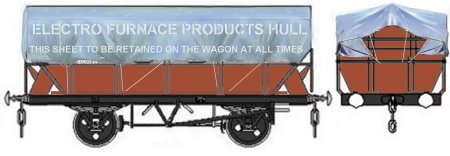
It seems likely that the sheeted 21 ton hopper was used for other duties, adding a card rectangle 'sheet supporter' and a blue tarpaulin with very faded markings would allow you to add this unusual vehicle to a rake of general goods wagons on some unspecified duty.
The 21 ton hoppers took a lot of hammer in everyday use an in the early 1970s a large number were re-bodied with simplified side strapping, the N Gauge Society kit is the best bet for a modification to represent this type.
Fig ___
BR rebodied 21 ton Hoppers
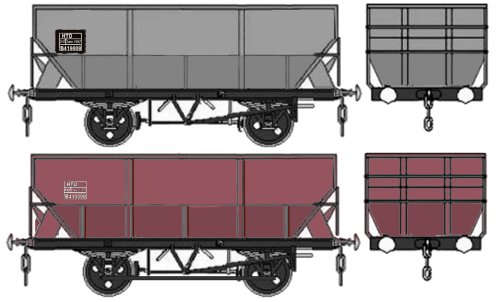
A larger twenty four and a half
ton mineral hopper was built on the same chassis. The overall appearance was
very similar to the original 21 ton hopper wagons, although the hopper itself was slightly higher, but this type was
never as common as the twenty one tonner.
At the other end of the scale British Railways also built a fleet of rather small hoppers on a ten foot wheelbase chassis with a capacity of 13 tons. Most were scrapped in the later 1960s but some survived into the 1980s, mainly in the Yorkshire area. As well as coal they were also used for stone and iron ore traffic. My model, shown below, used the sides and vertical ends of the N Gauge Society iron ore hopper kit with detailing added from wire and strip and a Peco ten foot wheelbase chassis.
Fig___ Model of the BR 13 ton coal hopper
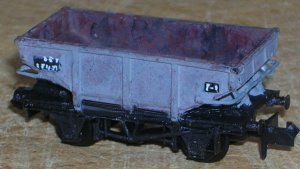
The British Railways designed
twenty five and a half ton 'ore' hopper was produced in some numbers. A kit of
this wagon is available from the N Gauge Society which fits onto a standard
Peco ten foot wheelbase steel chassis. These wagons were also used for sand and
limestone.
Fig___ Models made using the N Gauge Society ironstone
hopper kit
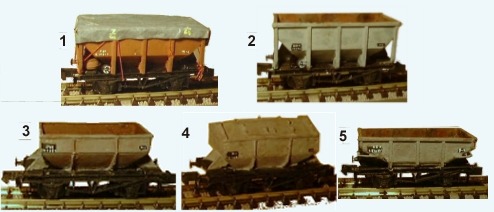
This kit can be built as the fitted version (1)
or the unfitted version (2) and can also be converted to represent an LMS
designed hopper (3), again intended for iron ore but also used for other bulk
cargo such as crushed stone. A variant of this LMS vehicle was produced with a
peaked roof for lime traffic (4). If you make either of the LMS wagons the
unused parts of the kit can be utilised to make one of the smaller types of BR
standard thirteen ton coal hopper (5). All these conversions are considered in
the section on Kit Bashing.
The fitted example of the BR hopper shown
above has been covered with a tarpaulin sheet, it is carrying a cargo of 'spent
grain' from a brewery to a cattle food works. Open hoppers of various types
have occasionally been specifically converted for other traffic by the simple
addition of a roof with loading hatches, or just a tarpaulin and its supporting
rail. The vacuum braked version of the twenty five and a half ton iron ore
hopper wagon, fitted with a frame carrying a plastic tarpaulin, formed the
basis of a powder wagon which saw intensive service in the Widnes area carrying
chemicals. There were several experimental conversions of this nature based on
the standard twenty one ton mineral hopper but most were one-off's.
The
ten foot wheelbase 'anhydrite' hoppers on offer as a kit from the N Gauge Society were an open hopper fitted with a bright
yellow tarpaulin, the material they carried is used in the manufacture of
sulphuric acid. They are often mentioned in railway texts but this is mainly
because they were one of the regular sights on the popular Settle &
Carslile line. In fact these wagons were confined to regular workings between
Billingham on the North East Coast and a quarry on the Settle & Carslile
line to an ICI works at Widnes in the Mersey estuary in Cheshire.
British Railways kept some
pre-war wooden and steel bodied grain hoppers in service into at least the
1960's. In the late 1950's they built more vacuum braked steel grain wagons to
the same basic design as the LMS wagons but with 'T' section side strapping. I
believe these remained in service until the mid 1980's. BR also added a sheet rail to some 21 ton mineral hoppers and used these for grain (and other) traffic. The only photo I have seen of a 21 ton grain hopper had no sheet in place but the tarpaulin on these wagons would have been similar to that shown above for the Electro Furnace Products hopper.
Fig ___
British Railways Grain Hoppers
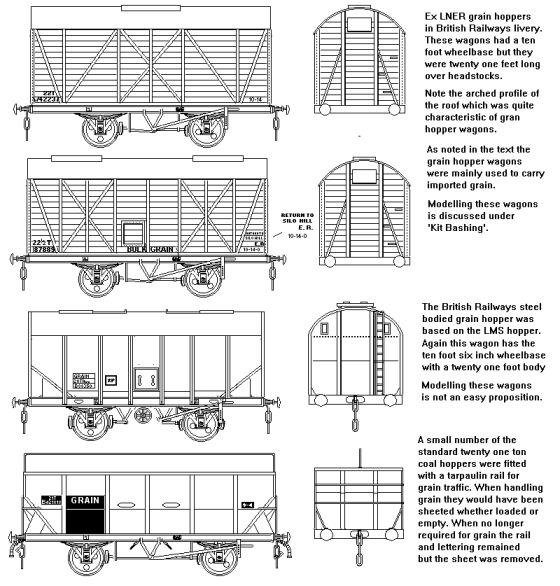
In 1952 British Railways introduced a standard twenty four and a
half ton payload hopper with a solid roof for granular powders which they coded
'COVHOP'. Production of the type continued until the early 1960's by which time
there were well over a thousand in service. They had a ten foot six inch
wheelbase with an overall length of about twenty five feet and were built in
three version, with hand brake only, hand brake and vacuum through pipe and
fitted with a full vacuum brake (TOPS codes CHO, CHP and CHV respectively).
They were seen all over the country carrying a range of granular materials
including soda ash, sand, Perlite (a white, granular insulating material) and
even sugar beet. Soda ash is a very effective paint remover and wagons in this
traffic often had little paint left on them. The COVHOP wagons used for sugar
beet traffic were sometimes repainted light blue. Unfortunately the COVHOP is
not available at all in N Gauge and represents something of a challenge for the
model maker.
Fig ___ British Railways COVHOP standard covered
hopper
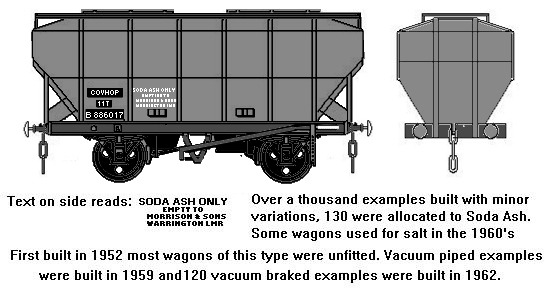
The Covhop had a long life, in the 1970s some were piped to run with air brake stock and appeared in rakes of British Industrial Sand PGA covered hoppers into the mid 1980s.
In the early 1950's 'air fluidisation' systems were developed
for handling fine grained powders such as cement. Air-fluidisation simply means
that air is blown into the powder, forcing its way between the grains and
loosening them. The powder then behaves much like a liquid and can be pumped or
drained from the wagon with relative ease. In the mid to late 1950's British
Railways built their 'Presflo' wagons for cement traffic. The Presflos had a
few problems, the cement tended to stick in the square corners, but they have
also been used for fullerís earth, slate powder alumina (in Scotland feeding the aluminium works at Braefoot Bay), sand, silica, salt (in a batch of specialised ICI liveried vehicles) and flour. From the mid 1960's some of
these Presflo wagons were purpose built and used by British Railways to carry fly ash from power
stations to land fill sites in block trains. Graham Farish have released
Presflos in a suitable plain livery for fly-ash traffic and these can also be
re-lettered as the original British Railways livery 'BULK CEMENT' Presflos.
Alternative lettering includes PRESFLO ALUMINA (used in North East Scotland)
and PRESFLO SALT. Presflos were coded CPV under TOPS and those used for power
station fly ash were coded CSV, this changed CSA after they were fitted with
air brakes in 1968. A small number of the standard vacuum braked presflo
wagons were modified for channel ferry traffic with an air pipe added and
securing lugs fitted to the chassis, these were coded CSW under TOPS (I understand they were intended to carry Fullers Earth). The
discharge valve and associated air pipe couplings were on one side of the wagon
only. Assorted liveries for these wagons have been included in the section on
Livery.
Fig ___ BR presflo wagons
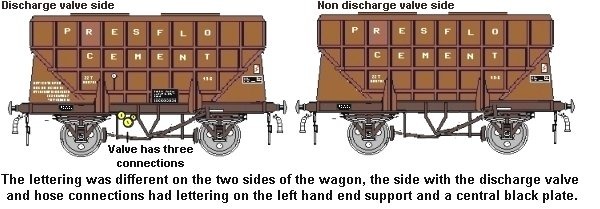
British Railways then adopted a twin-silo design which they
called the 'Prestwin', building a fleet of these from 1960. The first
batches, Diagram 1/274, were built on a standard British Railways ten foot wheelbase chassis.
The last batch of 100 wagons to Diagram 1/277 had a nineteen foot six inch long chassis with a twelve foot
wheelbase and with lower but larger tanks. These wagons remained in use until about 1983.
Fig ___ BR prestwin wagon
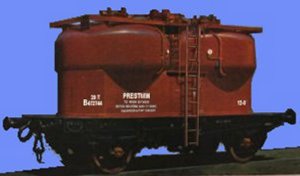
Something similar to the later
design was available in the Lima range but fitting this on a cut-down Peco
fifteen foot chassis with the ends cut back improves the look and running characteristics. You may
find second hand Lima models or other manufacturers continental liveried
versions of this wagon but a re-paint in plain bauxite is all that is really required.
The chassis on the Lima model is too high (all Lima models suffered from this)
and the underframe on the BR wagons had a V hanger and brake handle. Also on
the BR Prestwin the footboards at the top extend to either side of the top of
the tank forming a rectangular 'frame' around the tops of the tanks, but
otherwise the continental models are pretty close. The model shown in the
photograph is a standard Lima type on its original chassis.
Fig ___
Lima prestwin (still on its Lima chassis)
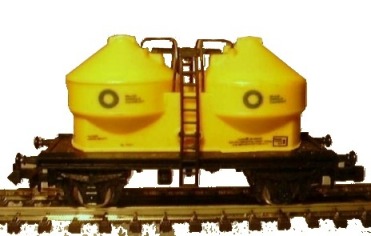
The bauxite liveried BR operated Prestwin wagons were used for cement, lime, hydrate of aluminium, soda ash, fertilizers and chalk but were mostly transferred to sand traffic in
the late 1970's when the cement firms started buying or leasing private owner
air-fluidised wagons. BR standard livery was bauxite with white markings, a sketch of
the BR bauxite livery showing the lettering has been included in the section on
Available Models under Lima.
In 1960 a fleet of long wheelbase 'cemflo' wagons was ordered, these had a cylindrical aluminium tank with the lower ends cut away at an angle (under which the vacuum cylinders were fitted). They ran on a 15 foot wheelbase, 21 foot over headstocks chassis whith a brake wheel rather than brake lever. Hornby produced an OO model at the time but no one has yet produced an N example as far as I am aware. The body is not too difficult, a length of dowel with the ends cut away wrapped in post card and some fuse wire for the side mounted pipe, but the chassis is more difficult. The chassis can be produced using a Peco 15 foot wheelbase chassis but the ends have to be brought in by cutting a V section 4mm deep, also later examples had holes in the chassis to further reduce the tare weight, making them even more difficult to model. When new they were supplied with a very light grey chassis and natural metal tank bearing the cement company logo. By the 1980s they were plain silver tank with a black patch to the right bearing the TOPS info panel as shown on the end detail inset. Note the yellow Cc panel, still in use in 1982.
Fig ___
Cemflo showing tank end arrangement and original livery
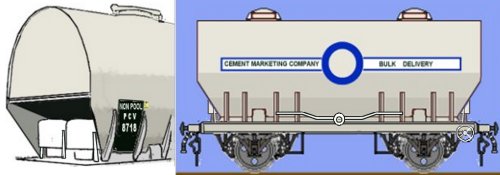
It is perhaps worth noting that the
three-to-a-wagon cement carrying L type containers continued in service into
the mid 1980's as well (in later years they were used to carry (I think)
limestone to steelworks). These Conflat L wagons are described in the section on Unit Loads and
modelling them is discussed in the section on Kit Bashing.
More recent
privately owned and leased designs of air-fluidised powder stock look like tank
wagons. Peco's Rugby Cement wagon is a good example, although this should have
some external pipe work on the non-ladder end. This type of cement wagon entered service in the later 1960s. As well as cement these air-fluidised vehicles are used for a range of chemical powders and both Peco and Graham Farish have released examples their modern image air braked range. Farish also offer the later 'depressed centre' cement tank wagon, introduced in the mid 1970s (the idea had been trialed on a small batch produced in the late 1960s). These came in various forms, the early examples had a fifteen foot wheelbase four wheel chassis but in the 1970's Blue Circle invested in 102 ton GLW wagons with two separate depressed centre aluminium tanks on a single bogie chassis. The tanks on these bogie vehicles were plagued with cracks and by the 1980's they had switched back to two axle designs for new vehicles. The bogie vehicles were coded PDA and they remained in service into the late 1980's and possibly the early 1990's.
In the 1950's
the pallet and the pallet handling fork lift truck became increasingly popular.
British Railways had to look at ways of dealing with palletised cargo. An early
success was pallets of bricks originally seen in Scotland, later throughout the
UK. British Railways modified existing medium sided (equivalent to three plank)
wagons, removing the sides and fitting a frame at each end with drop-in side
panels. These were coded 'PALWAG' but in the 1960's purpose built vehicles to
an essentially similar design appeared coded 'PALBRICK'. You can model these
using either a Graham Farish or Lima ten foot chassis, notes on this will be
found in the section on 'Kit Bashing'. See also the section on Unit Loads.
Fig ___ Palbrick wagon models

Existing vans were not suited to
carrying palletised loads. British Railways experimentally modified a few ex
LMS vans, fitting them with larger doors. The next design was a modified
version of the pre-war GWR standard ventilated van. Introduced in the late
1950's these were fitted with larger than normal double doors off-set toward
one end of the body. These vans, coded PALVAN, had rollers mounted on the floor
to allow the pallets to be moved along the wagon. The Parkwood Models range
includes a kit for one of the early designs with two alternative sets of side
doors to ad variety to the rake.
In about 1960 British Railways
produced an all-plywood pallet van, again with large double doors offset to the
left hand end on each side of the vehicle. A shock-absorbing version was also
produced having plywood sides but the standard British Railways corrugated
steel ends. About 2,000 plywood bodied British Railways palvans were built and
they were seen all over the system throughout the 1960's. All of these palvans
were originally rated as suitable for express goods trains and branded XP. In
use they were found to be unstable at high speeds and were later de-rated.
Never a great success, mainly due to the riding characteristics, most had been
withdrawn and condemned by the mid 1970's.
Fig ___ Drawing of early
British Railways pallet vans
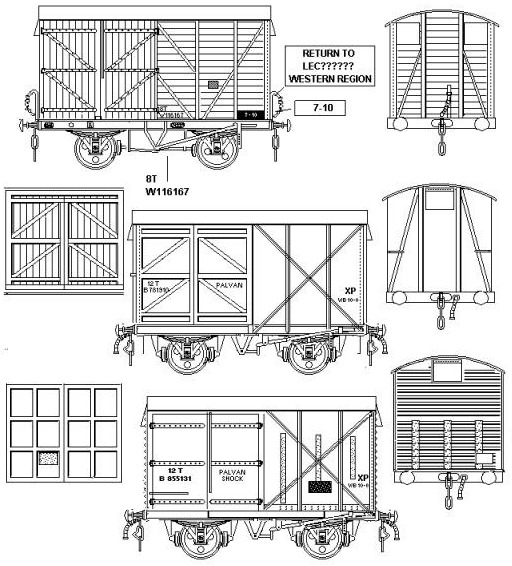
There were several alternative designs for pallet vans produced
in the 1960's, one of the more successful is shown in the sketch below.
Unfortunately this had an eleven foot wheelbase and a body rather longer than a
standard van so when I tried to model the thing using a Peco refrigerated van
as a basis the result was not terribly convincing. The plywood bodied open
wagon also shown in the sketch was one of a number converted from old Plate
wagons to carry palletised beer barrels. These varied a bit in the layout of
the doors on the sides. They can be modelled on a Peco long wheelbase chassis
with a plastic card and Microstrip body.
Fig ___ Later pattern
British Railways pallet van and palletised 'ale' wagon
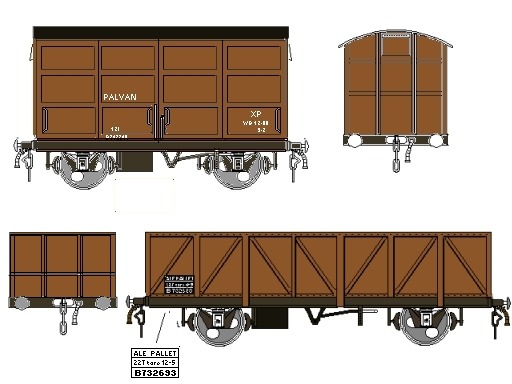
Palletised beer was also apparently shifted in some unmodified
'tube' wagons. Presumably these were the drop-side twelve foot wheelbase type
coded SOV under TOPS, a model of which is available from Parkside Dundas.
I built a few pallet vans prior to the arrival of the Parkwood Models
range, and these serve to brake up a rake of Parkwood vans.
Fig ___
Pallet van models
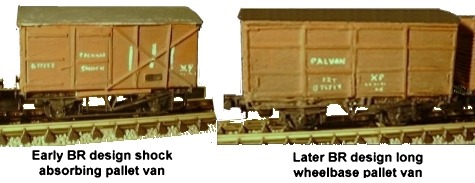
One problem with traditional designs, and the BR Palvans
was that the pallets had to be moved about inside the van when loading and
unloading. Two methods of getting round this were developed, the first was the
'curtain sided' van. These had canvass sides and on early types there was a set
of hooks along the chassis to allow the sides to be roped down, by the mid
1970's this was replaced by a series of short straps (originally developed for
road lorries where I believe they were marketed as 'tautliner'). The problem
was that loads were often not secured very well to the pallet and if the load
shifted the side of the van would bulge out, taking it 'out of gauge'. This
problem persisted until securing loads to pallets became the norm in the mid
1970's, even then the entire pallet might shift, especially on a part loaded
vehicle. BR developed a simple aid for palletised loads in the form of a ring
of steel with serrated edges, the serrations were bent in opposite directions,
one 'up' the next 'down', these discs were laid on the wooden floor of the
vehicle and the pallet placed on top. The teeth on the top and bottom edges bit
into the wooden floor and pallet and held the load fairly secure.
The
next idea for pallet carrying vans was the 'sliding wall van' in which the side
of the van is made up of (typically) two sliding doors. One door is pulled
across allowing full access to one end, then the doors are both moved along to
the other end allowing full access to the opposite end. The 'pallet van' model
offered by Peco is a British Railways built sliding wall van introduced for
Ford motor company parts traffic in the early 1960's. Over a hundred of these
vans were built, unfortunately this model uses the standard Peco underframe and
is rather short (see entry in Available Models - Peco).
British Railways
was open to requests from good customers for specialised rolling stock and
Metal Box Ltd (now Carnaudmetalbox plc) was one such customer. They regularly
shipped empty cans (and lids) to soup factories and British Railways built a
hundred vans with no side doors and doors in only one end for this traffic. You
can model a couple of these using a Parkwood Models kit and a Peco ventilated
van kit. The Parkwood Models kit comes with 'spare' ventilated ribbed steel
ends, if you have a set with an end vent left over you can replace one end of
the Peco kit with the Parkwood ribbed steel type. Add a strip of 20x30 thou,
trimmed to a diagonal shape, to the Peco sides to represent the diagonal steel
corner plates and sand this down to about 10 thou thickness. Carve and sand the
details from the other end of the Peco van body and scribe in the end door
plank details, adding strapping from 10x20 thou strip. You need to cut away the
section of the body with the doors and fill in the resulting gap where the
doors used to be with scribed card and add a vertical T section strap using
10x20 thou strip with a 10x10 thou strip down the centre. Filling in this gap
is best done after the body has been mated with the chassis. Mount the modified
body on a Peco chassis. Trim any rain strips from the Peco roof and add four
shell vents. Prior to the arrival of the Parkwood Models kits I made a couple
of these van using one end of a Peco van and one end of a Lima van with the
resulting body mounted on a Peco chassis. Using one Peco van and one Lima van
you get two of these tin can vans. These were fitted vans painted in standard
British Railways bauxite livery. The patch of colour on the side of the van in
the sketch is a 'traders label', these are more fully discussed in the section
on Livery.
Fig ___ British Railways end-door van used for delivering
empty soup cans
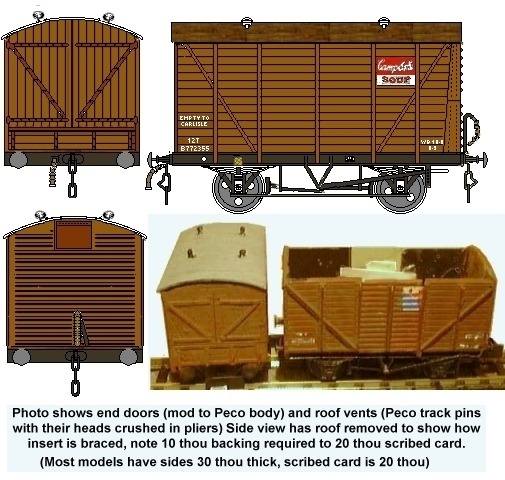
In the late 1950's it became apparent that British Railways had
more wagons than they needed and the practice of ordering large numbers of new
wagons was discontinued. Wagons not required for service were now destroyed or
sold for scrap rather than being stored and British Railways started to make
more use of conversions of existing vehicles for new traffics.
By the
time of Mr. Beeching's report on the railways in mid 1960's the ten foot wheel
base four wheeled wagon carrying perhaps ten tons remained the standard but the
profile of the rolling stock had changed. The number of vans had increased
whilst the proportion of open general merchandise wagons had been reduced.
There were now nearly fifty thousand assorted containers in use (the wagons for
which amounted to about one in fifteen of the rolling stock total) including
many specialised types for particular traffics. The pre-war open container had
virtually disappeared but most closed containers were still the built to the
pre-war wooden bodied designs. The number of vacuum fitted vehicles on the
system peaked at just over three hundred thousand in 1961.
By the end
of the 1960's the British Railways wagon fleet had shrunk to a total of about
four hundred thousand vehicles, about half of which were fitted types and
negotiations with the Unions were under way to do away with the brake van on
the rear of fully fitted trains. The service vehicle fleet had remained stable
at about the thirty thousand level but by the end of the 1960's these were
increasingly purpose-built vehicles in which steel construction was replacing
the damage prone wooden bodies.
British Railways focused their efforts
on larger customers who might be persuaded to ship by the train load in Mr.
Beeching's 'company trains'. The British Steel Federation predicted a major
demand for steel carrying wagons and to meet this predicted demand British
Railways spent a lot of money on building and upgrading the steel carrying
stock.
There were a large number of conversions or upgrades based on
older types of wagon for steel traffic. The Bogie Bolster A was a conversion
based on ex military 'rectank' wagons, only thirty four feet over headstocks,
not many of this type were built. The Bogie Bolster B was actually based on two
different types of wagon, both originally built for wartime military use. Both
were over forty feet long, some were 'Warflat' wagons others were bogie well
wagons formerly coded 'Warwell'. Parkwood models offer both the warflat and the
warwell in their range and Bachman offer a bogie well wagon which would serve
as a reasonable basis for the forty seven foot Warwell type. To carry the steel
the warwell wagon had metal frames supporting two bolsters in the middle of the
well, with two more bolsters at either end sitting on pairs of small metal
brackets. The engineers also modified some of these wagons, adding a full
length wooden 'floor' supported on steel girders with a total of four bolsters.
Both of the Warwell based wagons lasted into the 1970's and as they were not a
common type they frequently travelled singly in a rake of more conventional
wagons
Fig ___ Warwell wagons converted for steel & engineers
traffic
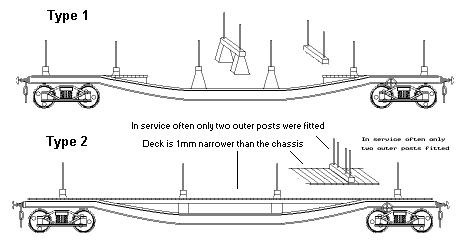
Modelling the supports on the steel carrier represents the only
real difficulty, the wooden decked platforms to either end of the well can be
represented with a scrap of 'planked' plasticard supported on Milliput and the
bolsters can be culled from the spares box or made using guitar top E string
and 1mm wide strips of forty thou card. The engineers vehicle needs a full
length deck of scribed card supported on a strip of forty thou card, the deck
is 1mm narrower than the wagon chassis. The supporting brackets under the
centre bolster are easier to make for this model as they are more or less
rectangular.
British Railways built large numbers of forty five foot
long Bogie Bolster C (based on the Great Western Railway Macaw B) and fifty two
foot long Bogie Bolster D (mostly based on the LNER 'Quint' bolster wagons).
Early builds were largely unfitted but later batches were all vacuum fitted.
The Bogie Bolster C wagons had the standard GWR plate frame bogies,
which are tricky to duplicate (you can add postcard cut-outs to a Graham Farish
diamond frame bogie but this is not easy). I do not know of any RTR or kits of
this wagon on the market and given the difficulty of making the bogies it is
not an easy option for the novice modeller to scratch build. These vacuum
braked wagons lasted in service into the early 1980's.
The LNER based
wagons were fitted with air braked bogies in the 1970's and operated throughout
the 1990's TOPS coded BDA. There are kits of the air braked BDA, unfitted BDO
and vacuum braked BDV available from John Grey (see the section on Available
Models for details) but if you pick up a cheap Farish coach at a swop-meet this
represents an easy first effort at kit bashing. For the LNER 'Quint' five
bolster wagon cut the battery box from a Graham Farish suburban coach
underframe and add a replacement truss rod from Microstrip. You need to replace
the bogies with 'goods' type but as these are shorter than passenger bogies you
need to cut back the ends of the chassis by about 3mm so you can retain the
existing bogie pivots. The result is very slightly over length but reasonable
as a fifty two foot LNER 'quint' or British Railways Bogie Bolster D. This
wagon would be suitable for use in any period from the 1930's to the 1970's.
The suburban coach body can be cut up and mounted on Peco fifteen foot
wheelbase chassis for an industrial 'workman's train'.
Fig___ LNER
Quint and GWR bolster wagons
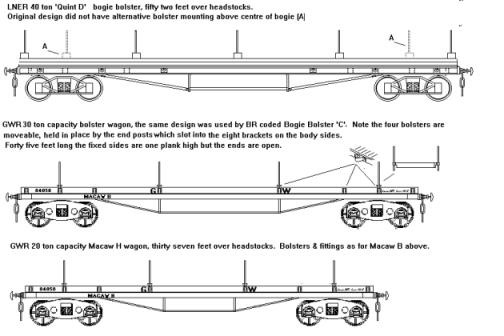
The Bogie Bolster E was a very solid
little wagon only thirty two feet over the headstocks. I do not know of a
suitable ready-to-run chassis for the Bogie Bolster E but the GWR did build a
number of short wagons with twenty tons capacity (the Macaw H, only thirty
seven feet over headstocks) and for this the Bachman Old Timer flat car can
form the basis of a reasonable model. You do need to add the buffers (you can
cut these from redundant Lima four wheeled wagons) and again you have the
problem of modelling the plate frame bogies.
The Graham Farish
'sulphate wagon' and bogie van both share the same underframe, a scale thirty
five feet long, which has some heavy trussing underneath. This chassis can have
a new body added to produce a short bogie vehicle which might pass muster as a
Bogie Bolster A or E although the latter should have the more modern freight
bogies such as those used on the large tank wagon and Freightliner wagon.
Specialised stock for various forms of steel traffic were developed by
British Railways, those used for coils of strip steel were often based on
conversions of older redundant designs. In the early 1960's redundant single
bolster wagons were fitted with wooden cradles to carry coils of strip steel.
The four wheeled Coil J (TOPS coded SJV) 24.5 ton strip coil wagons were built
in the early days on ten foot wheelbase ex-tippler chassis. A model of this
wagon to suit the Peco nine-foot wheelbase chassis is available as a kit in the
Parkwood Models range.
Fig___ Early BR 'Coil J' wagon
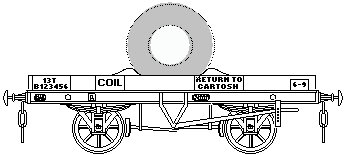
The long wheelbase (Peco type) plate wagon served as the basis for four
types of coil wagon, some of these were converted in the mid 1960's to carry
coils of steel wire or rod (Coil R and Coil E) whilst others were converted to
carry coils of steel strip (Coil D and Coil F).
In the early 1960's
British Railways converted some unfitted pre-war fish belly bogie flat wagons
to carry strip coils from South Wales, these had two heavy wooden beams laid
along the wagon with a cross bolster fitted with two steel posts at each end.
The coils were carried with the holes through their centres facing the end of
the wagon.
A subsequent design, developed in the 1970's and based on ex
War Department (now Ministry of Defence) fish-bellied bogie wagons, supported
the coils on a series of metal frames. These wagons were fitted with both air
and vacuum brakes as they were intended for possible deployment to the
Continent and they saw service on cross channel ferries with exports of steel.
These wagons are 'tented' with two unequal sized nylon hoods originally coded
JKX and JNX under TOPS these were re-coded BNX in the mid 1980's and lasted in
service into the 1990's.
A lot of strip coils were shipped to be zinc
coated or otherwise treated and these coils have to be protected from the
weather so many coil wagons were fitted with canvass awnings, tent shaped and
acting rather like the hoods fitted to prams. On these hooded types the hoods
were only lowered for loading and unloading, which saves you having to make the
rolls. Unfortunately most of the hoods were removed by the late 1970's however
the coils were often draped with a tarpaulin. Similarly the coils of wire would
be covered with a tarpaulin when on the move (most photographs of the type I
have seen have been taken at the loading or unloading point where the sheets
were not in place).
Modelling various coil wagons is discussed in the
section on Kit Bashing, making the coils of strip steel and wire is discussed
in the section on Cargo & Wagon Loads.
After the Second World War
the rail movement of farm machinery declined, partly because farm equipment
increased in size to the point where it could not easily be moved by rail. At
the time that standard designs were being built in their thousands British
Railways only built one hundred and fifty of the machinery carrying 'Lowmac'
wagons although they had quite a few of the inherited Big Four designs in
stock. These wagons received relatively little use and so lasted in service for
many years, mainly used for military traffic such as lorries, road building
machinery and artillery.
Traffic in motor cars increased steadily at
this time although facing stiff competition from the road haulage operators.
Open motor car carrying four wheeled flat wagons built by the Big Four railway
companies for carrying horse drawn carriages (and later for motor cars)
continued in use for carrying motor cars. The example shown below can be produced from the Peco bolster wagon as shown in the sketch below, this type was unusual in having drop ends rather than metal hoods over the buffers. If the model is loaded you need only cut away the central pivot, leaving the curved runners on the floor.
Fig___ BR (ex SR) Carfit S
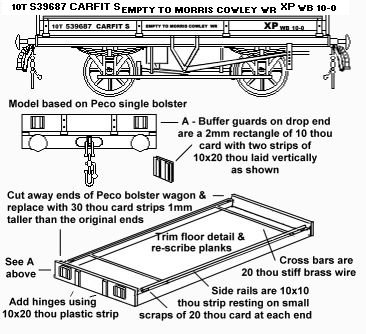
These wagons generally had low sides,
often in the form of a metal rail supported on posts. Metal cross-bars were
attached to the side rails and securing straps or chains were attached to
fittings on the deck or side rails. The chains were covered in rubber hose and
were fitted over the axle of the vehicle. Photographs of models of an LNWR open carriage truck and a Midland Railway CCT (covered carriage truck)will be found in the section on Goods Rolling Stock Design - Specialised Rolling Stock.
In the early 1950's British
Railways built a number of basically similar open four wheeled vehicles with a
flat wooden deck using their standard ten foot wheelbase chassis. Both vacuum
braked and hand brake only versions were built (called Carfit and Cartruck
respectively). They were mainly used for new cars from the Morris (later BMC)
works at Cowley near Oxford. In 1958 British Railways built some similar wagons
equipped for train ferry use which they coded Carfit C. These Carfit and
Cartruck wagons remained in use into the early 1960's. Pre-war open carriage
trucks and early British Railways 'carfit' and 'cartruck' wagons are described
in the section on Kit Bashing.
Fig___ BR cartruck
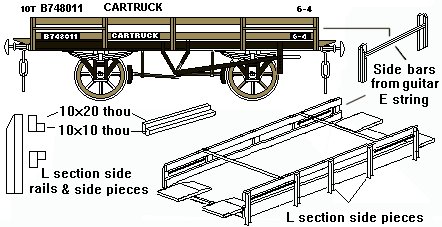
Bogie open flat wagons for motor car
traffic were called carflats, quite a number were built by British Railways on
pre-nationalisation passenger coach underframes (subject to them having a
minimum length of 57 feet over headstocks) and later on British Railways
standard Mk.1 chassis. The early type had a planked floor with metal sides and
two strips of metal running up the centre to form wheel-guides into which
angled metal plate chocks could be fitted. Subsequent builds (including the BR
Mk 1 underframes) had an open wooden deck with sturdy side rails supported on T
shaped stanchions along the sides, on these yellow chocks with steel pins on
the base were kicked into the decking to secure the cars in place. The older type can be modelled easily using a Graham Farish 'suburban' coach underframe, you need to cut away the 'battery boxes' to leave a simple open framework. The deck is from 1mm scribed card with 20x30 thou strips on the outside edges. The body can be cut down to produce two four-compartment coaches which run on Peco 15' brake van chassis.
Fig___ BR carflats
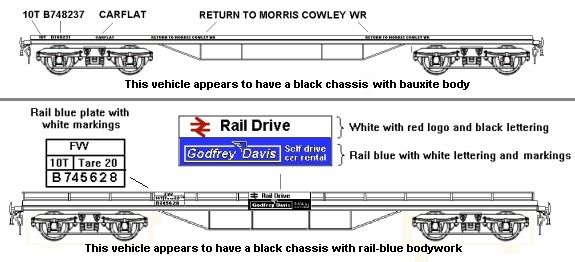
The British
Railways Mk.1 coach was the last to use a separate chassis and body, later
coach designs were built using a stressed body with no chassis as such and so
could not be converted to carflats. One small point is that carflats on ex
Southern Railway chassis were all Private Owner stock, converted in 1963 for
MAT who used them for ferry traffic, they remained in use into the 1980's. The
British Railways Carflats were used both to carry new cars and also for
`Motorail' services. For more on the development of motor car carrying vehicles see Goods Rolling Stock Design - Specialised Rolling Stock.
In 1957 a bogie
car-carrying vehicle called Tierwag was produced for a company called MAT
Transauto for use on the train ferries. The Tierwag had a raised upper deck
able to hold four small cars of the Morris Minor class and a dropped centre
section between the bogies which could carry two more. These wagons were used
initially by the BMC motor car company but there were a lot of problems with
the hoist mechanism which accessed the lower section and these wagons were all
withdrawn by 1970, replaced in service by the SR coach based carflats mentioned
above.
The British Railways four wheeled CCT (which was offered in the
Lima range) and the bogie GUV vans (available from Graham Farish) had end
doors, and were designed with the carriage of motor vehicles in mind. The
British Railways standard CCT and GUV were used for the Motorail services in
the early days, presumably alongside the more up to date pre nationalisation
CCT stock. The four wheeled CCT vehicles, both pre-war and British Railways
built, could only carry one or two cars. The older vehicles were withdrawn from
service and the new BR built vans transferred to parcels duties by the mid
1960's.
To carry the body parts for motor cars British Railways built
more Bocars on redundant fifty seven foot passenger coach underframes.
Fig___ British Railways Bocar

These vehicles all had the low rather flat roofs and canvass sides as
described above. The British Railways Bocars were divided into a four bays by
the roof support pillars, each end bay was sixteen feet long whilst the two
centre bays were just over fourteen foot long and just over nine feet wide.
^
Go to top of page
International Good Guys ~ Making the world a
better place since 1971 ~ Site maintained by

All material Copyright © Mike
Smith 2003 unless otherwise credited

































